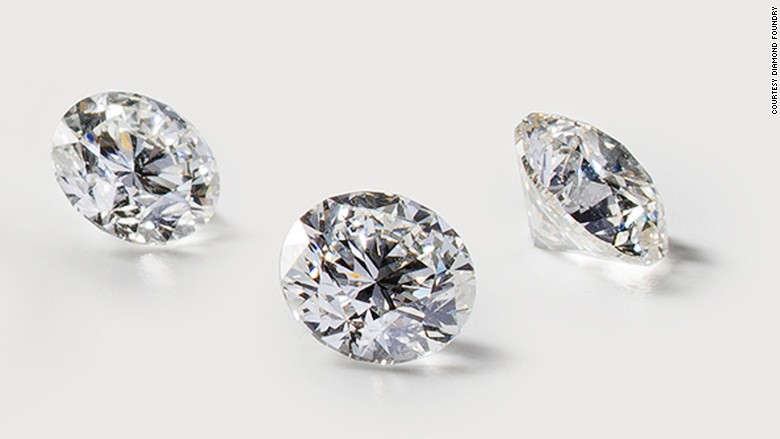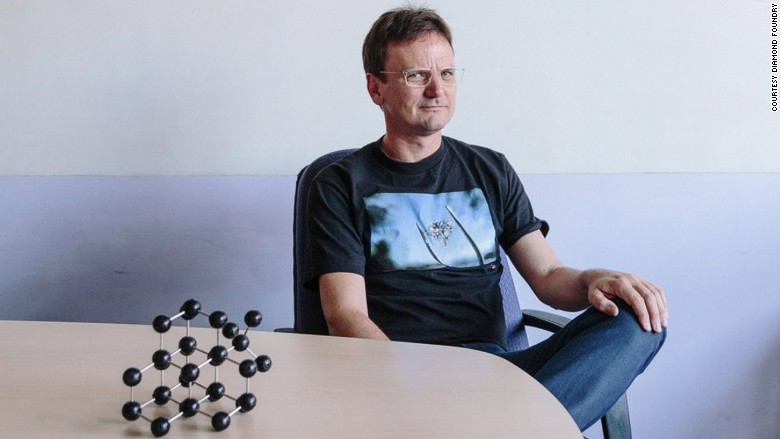
There may be a new gem among Silicon Valley's glittering startup scene. A Santa Clara-based company is creating jewelry-grade diamonds in a lab, using a plasma reactor that reaches temperatures as hot as the sun.
Natural diamonds are made from pure carbon and form over billions of years under high pressure and temperature, at depths of over 100 km in the Earth's mantle. But Diamond Foundry grows its stones inside a plasma reactor, atom by atom, from a tiny slice of a "mother diamond" mined in Canada. The process takes about a month.
The idea is to produce diamonds that are indistinguishable from their natural counterparts, but free of the controversies associated with real diamonds.
Related: World's most expensive rough diamond sells for $63 million
The diamond industry has been tainted by its association with "blood diamonds," which are mined to fund conflict and civil war. The profits have been used by warlords and rebels to buy arms during conflicts in Angola, the Democratic Republic of Congo (DRC) and Liberia. As well as diamonds fueling conflict, thousands of men, women and children in countries such as Sierra Leone have been used as slaves to extract diamonds using primitive, back-breaking methods.
The Kimberley Process, which regulates the trade of rough diamonds, says conflict diamonds make up only 0.1% of the world's current production. But buying from Diamond Foundry should give consumers total peace of mind.
"We have sustainable diamonds that have none of these practices involved," says Diamond Foundry's Austrian-American CEO and founder Martin Roscheisen.

When their solar energy company Nanosolar folded in 2013, Roscheisen's team of MIT, Stanford and Princeton schooled engineers needed a new project focusing on sustainability. "We like businesses that do good, in addition to being profitable," explains Roscheisen.
After two years of research and development, the company launched its diamonds in November 2015. Teaming up with cutters and designers, it sells engagement rings and loose diamonds of various cuts online.
High-profile investors
The company raised capital of over $100 million from 12 billionaires, including Twitter founder Evan Williams and actor and environmentalist Leonardo DiCaprio, who contacted Diamond Foundry after hearing about them.
"Nobody knew about us then, but it's pretty rare for Silicon Valley to have a tech company focused on diamonds, so word of mouth was going around," says Roscheisen.
DiCaprio, who starred in the 2007 film "Blood Diamond," which explores the conflict around the mining industry in war-torn regions of Africa, has endorsed the company's ethical approach to diamond production.
"Proud to invest in Diamond Foundry -- a co reducing human & environmental toll by sustainably culturing diamonds," the actor tweeted in November.
A novel approach
There are other companies out there making synthetic diamonds, but Diamond Foundry's approach is a novel combination of high-quality stones, bespoke cuts and environmentally conscious energy usage, says Roscheisen.
The plasma produced by its reactor is around 10,000 degrees Fahrenheit -- as hot as the outer core of the sun, Roscheisen explains, describing it as "a sun on Earth." It is a costly and energy-intensive process, but the use of solar and hydropower results in a zero carbon footprint, according to the company.
In terms of the technology, Roscheisen says what sets it apart is the ability to produce high-quality diamonds, thanks to a method involving high temperatures, as opposed to high pressure, and a cooling technology that results in pure and large stones.
In demand
More production facilities are planned in San Francisco and London. For now, the Santa Clara site produces 1,000 carats a month, which is between 150 and 300 gems from every two-week batch. So far, the largest it has grown was a 12-carat stone.
Demand exceeds supply, says Roscheisen. "Everything we produce sells out within two weeks," he adds.
The lab-grown gems cost the same as mined diamonds, with the online price set at 10% to 15% below market price, according to the company. A loose diamond from its online shop costs from $305 for a 0.38 carat round-cut gem to $23,000 for a 2.30 carat gem.
They come certified by the Gemological Institute of America and are as real as those dug out of the ground, says Roscheisen.
"A diamond is a diamond," says Roscheisen. "Scientifically it is a tetrahedral carbon allotrope, and it is the same thing whether mined or man-made."

